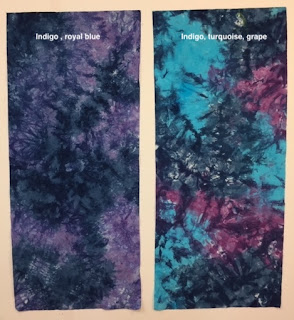I'll start with a recent craft project. Along with most everyone with a sewing machine, I've been making cloth face masks for a few months.
I use a pattern given in the New York Times at the end of March. Soon after I started making them (in early April), the local natural foods store asked if I would be willing to supply them with masks, since people had been asking for them. I wasn't interested in making money on the masks, and I also didn't want to be spending more than a few hours a week sewing masks, so we came up with this idea: I supply the store with about ten masks a week, at no cost. They have them on display, with a sign explaining that the masks are available in exchange for a donation to local food relief groups. Suggested donation is $10, but anything smaller is also happily accepted. So far, this has generated about $600 in donations. This definitely helps motivate me to keep making masks! I thought the masks might stop selling at this point, since they are now readily available in stores, but apparently not--people like the style, and they like that the money is going to a good cause.
Until recently, I made the masks with one layer of batik (recommended because of its tight fabric weave) and one layer of printed quilter's cotton, all from my stash of fabric. When I ran out of batik, I bought a couple of half-yards from a local shop. But rather than continue to buy fabric, I realized I could do some hand-dyeing on a bolt of fabric I rarely use, because it is so tightly woven that I can't hand-stitch into it (Testfabrics 419). It's perfect for this use! And it gives me the chance to do a fun kind of dyeing that I rarely use--mixing two or three different colors in a random pattern. (The dyeing I do for my quilts is almost all one-color solids or near-solids.) Below are six different strips I've dyed in the last couple of weeks. For any dyers reading, these are all with Procion MX dyes, color names noted on the photos. The "indigo" is a premixed dye from Dharma Trading; the rest are from Pro Chemical and Dye. For ease of use, I went with either primaries or pre-mixed colors. Now that I've got a method down, I'll probably mix some of my own colors, and extend the range.
It's always fun to look up close at a smaller section of the fabric (click on photos to enlarge):
I took another photo with the four 13" panels placed right next to each other. Hmm, something like this might be nice as a simple quilt top, maybe separated by narrow strips of solid fabric. . .









Those look great, Penny. And it is definitely nice that you can help the community like that.
ReplyDeleteI love the batik with made with indigo, turquoise & grape! It's so alive!
ReplyDeleteAnd that's a great choice to have donations go to local food relief groups.
ReplyDeleteWell done!
ReplyDeleteAh yes, Testfabrics 419 -- when I first learned to dye fabric, 20+ years ago, I bought 40 yards of it and dyed them all. Absolutely gorgeous!!!! But then I used some to make a quilt, and needed to take out a line of quilting, and learned that you never get rid of the needle holes. And yes, you can't stitch through it by hand. I still have most of the fabric because it's too hard to actually use. Maybe I should make some of it into masks!!
ReplyDeleteIsn't it great to do something good. Love the donation thing and looking forward to upcoming posts about your new project.
ReplyDeleteLove this! What a great idea to raise money for local food relief group!
ReplyDelete